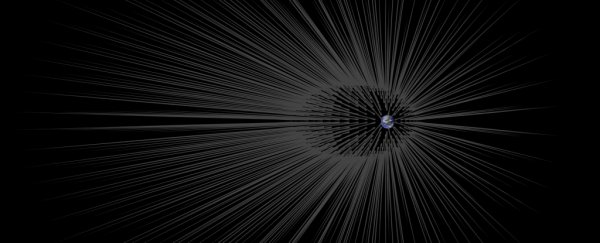If astronomers' calculations are correct, the Solar System is right in the middle of a turbulent space event: a vast 'hurricane' of dark matter, blowing at an insane speed of 500 kilometres per second (310 mps).
We can't see it, and we can't feel it - but it could mean that a direct detection of dark matter is closer than we thought.
Dark matter is one of the big conundrums of the Universe. We have never directly detected it, and we don't know exactly what it even is - but we do know that it's out there. We can infer it based on the motions of the stars and galaxies, which are far too fast for the amount of observable mass.
So there's something else out there, some other mass creating the gravity to influence those cosmic movements. We can even, based on those movements, calculate that invisible mass. "Dark matter" - whatever that might be - is the name we give that mass, and scientists are working on ways to detect it directly.
But we're not there yet. So how do physicists know we're in the middle of a tremendous storm of dark matter? The clue lies in the motion of the stars.
With the release of data from the Gaia satellite last year, astronomers discovered a stellar stream, the dissolving remains left behind by a large dwarf spheroidal galaxy that was eaten by the Milky Way many years ago.
There have been several such streams of stars detected in the Milky Way, but S1, as it is now known, is unusual in that the neighbourhood of the Solar System is smack-bang right in its path of 30,000 stars.
None of them are going to hit us - so you can relax about any fears you might have harboured of fiery stellar death - but it does mean that the dark matter associated with this last shred of the cannibalised dwarf galaxy is moving along with the stream.
Theoretical physicist Ciaran O'Hare from the University of Zaragoza in Spain has led a team of researchers in figuring out the effect of S1 on the dark matter in our little corner of the galaxy.
They looked at different models for the density and distribution of the dark matter flowing in on the S1 stream, and then predicted the dark matter signatures for these models that could be picked up by our detectors here on Earth.
One of these potential signatures is produced by the hypothetical weakly interacting massive particles, known as WIMPs. If these particles exist, we should be able to detect them via their collisions with electrons or atomic nuclei, which would cause charged particles on Earth to recoil, producing light that could be picked up by liquid xenon or crystal detectors.
Based on their calculations, the team determined that these WIMP detectors are unlikely to see any effect from S1, although it's possible that future tech, as it becomes more refined and advanced, could.
Axion detectors - such as the Axion Dark Matter Experiment - have a better chance, they determined. Axions are, again, only hypothetical at this point. If they exist, they are incredibly light, around 500 million times lighter than an electron, and it's possible they are a principal component of cold dark matter.
According to calculations by theoretical physicist Pierre Sikivie, these ultralight particles - which we can't see - could be converted to photons which we can see, in the presence of a strong magnetic field.
"Axion haloscopes possess by far the greatest potential sensitivity to the S1 stream if its dark matter component is sufficiently cold," the researchers wrote in their paper. "Once the axion mass has been discovered, the distinctive velocity distribution of S1 can easily be extracted from the axion power spectrum."
The Axion Dark Matter Experiment, as far as we know, hasn't made an S1 detection either. But knowing what to look for could help scientists improve the chances of this - and if no detection is made, improve detection technology for the ongoing search for dark matter in the future.
The team's research has been published in the journal Physical Review D.
